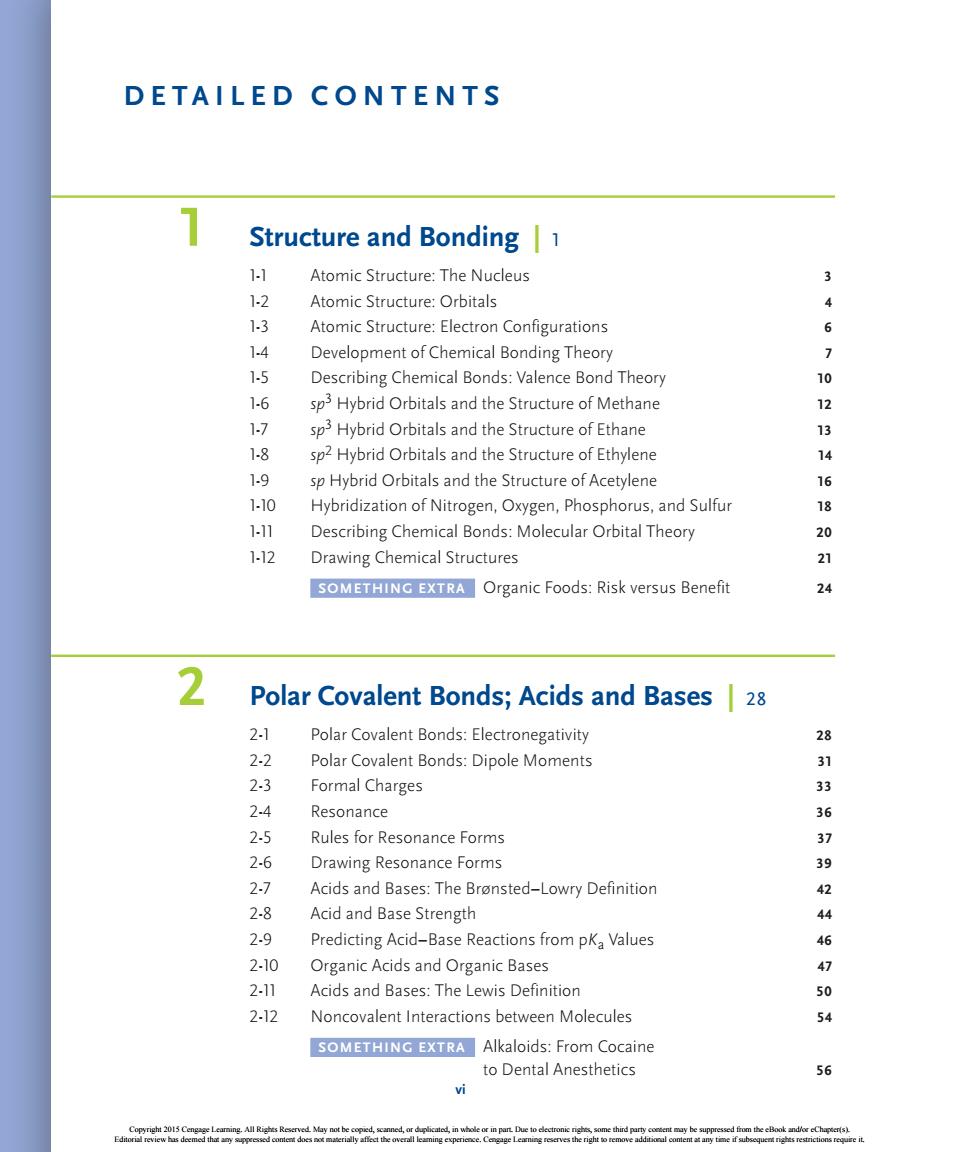
DETAILED CONTENTS Structure and Bonding1 1-1 Atomic Structure:The Nucleus 3 1-2 Atomic Structure:Orbitals 4 13 Atomic Structure:Electron Configurations 6 1-4 Development of Chemical Bonding Theory 1-5 Describing Chemical Bonds:Valence Bond Theory 10 1-6 sp3 Hybrid Orbitals and the Structure of Methane 12 17 sp3 Hybrid Orbitals and the Structure of Ethane 13 1-8 sp2 Hybrid Orbitals and the Structure of Ethylene 14 1-9 sp Hybrid Orbitals and the Structure of Acetylene 16 1-10 Hybridization of Nitrogen,Oxygen,Phosphorus,and Sulfur 18 1-11 Describing Chemical Bonds:Molecular Orbital Theory 20 1-12 Drawing Chemical Structures 21 SOMETHING EXTRA Organic Foods:Risk versus Benefit 24 Polar Covalent Bonds;Acids and Bases 28 21 Polar Covalent Bonds:Electronegativity 2-2 Polar Covalent Bonds:Dipole Moments 31 2-3 Formal Charges 24 Resonance 2.5 Rules for Resonance Forms 37 2-6 Drawing Resonance Forms 27 Acids and Bases:The Bronsted-Lowry Definition 42 2-8 Acid and Base Strength 29 Predicting Acid-Base Reactions from pKa Values 46 2.10 Organic Acids and Organic Bases 47 2-11 Acids and Bases:The Lewis Definition 50 2-12 Noncovalent Interactions between Molecules 54 SOMETHING EXTRA Alkaloids:From Cocaine to Dental Anesthetics
D e t a i l e D C o n t e n t s 1 structure and Bonding | 1 1-1 atomic structure: the nucleus 3 1-2 atomic structure: orbitals 4 1-3 atomic structure: Electron configurations 6 1-4 Development of chemical Bonding theory 7 1-5 Describing chemical Bonds: Valence Bond theory 10 1-6 sp3 hybrid orbitals and the structure of Methane 12 1-7 sp3 hybrid orbitals and the structure of Ethane 13 1-8 sp2 hybrid orbitals and the structure of Ethylene 14 1-9 sp hybrid orbitals and the structure of acetylene 16 1-10 hybridization of nitrogen, oxygen, phosphorus, and sulfur 18 1-11 Describing chemical Bonds: Molecular orbital theory 20 1-12 Drawing chemical structures 21 soMetHinG eXtra organic Foods: Risk versus Benefit 24 2 Polar Covalent Bonds; acids and Bases | 28 2-1 polar covalent Bonds: Electronegativity 28 2-2 polar covalent Bonds: Dipole Moments 31 2-3 Formal charges 33 2-4 Resonance 36 2-5 Rules for Resonance Forms 37 2-6 Drawing Resonance Forms 39 2-7 acids and Bases: the Brønsted–lowry Definition 42 2-8 acid and Base strength 44 2-9 predicting acid–Base Reactions from pKa Values 46 2-10 organic acids and organic Bases 47 2-11 acids and Bases: the lewis Definition 50 2-12 noncovalent interactions between Molecules 54 soMetHinG eXtra alkaloids: From cocaine to Dental anesthetics 56 vi 42912_00_FM_i-xxiv.indd 6 1/16/14 3:00 PM Copyright 2015 Cengage Learning. All Rights Reserved. May not be copied, scanned, or duplicated, in whole or in part. Due to electronic rights, some third party content may be suppressed from the eBook and/or eChapter(s). Editorial review has deemed that any suppressed content does not materially affect the overall learning experience. Cengage Learning reserves the right to remove additional content at any time if subsequent rights restrictions require it
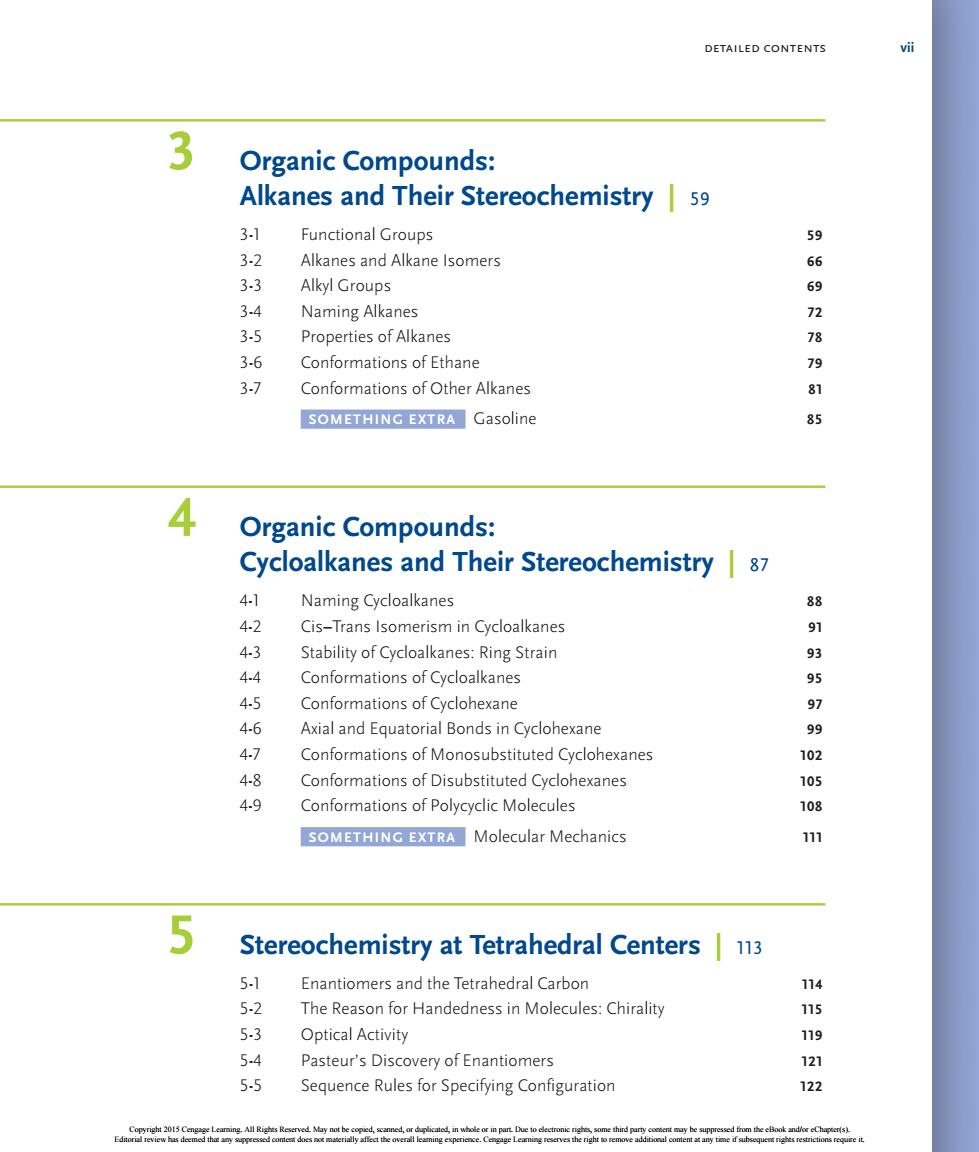
DETAILED CONTENTS 3 Organic Compounds: Alkanes and Their Stereochemistry 59 3.1 Functional Groups 59 2 Alkanes and Alkane Isomers 33 Alkyl Groups 9 34 Naming alkanes 3-5 Properties of Alkanes 78 3-6 Conformations of Ethane 79 3 Conformations of Other Alkanes 81 SOMETHING EXTRA Gasoline 85 Organic Compounds: Cycloalkanes and Their Stereochemistry 87 41 Naming Cycloalkanes 88 42 Cis-Trans Isomerism in Cycloalkanes 91 Stability of Cycloalkanes:Ring Strain 4-4 Conformations of Cycloalkanes 95 45 Conformations of Cyclohexane 4-6 Axial and Equatorial Bonds in Cyclohexane 4-7 Conformations of Monosubstituted Cyclohexanes 10 Conformations of Disubstituted Cyclohexanes 105 4-9 Conformations of Polycyclic Molecules 108 SoMETHING EXTRA Molecular Mechanics 11m 5 Stereochemistry at Tetrahedral Centers 13 5-1 Enantiomers and the Tetrahedral Carbon 14 5-2 The Reason for Handedness in Molecules:Chirality 115 53 Optical Activity 54 Pasteur's Discovery of Enantiomers 5-5 Sequence Rules for Specifying Configuration 名
DetaileD Contents vii 3 organic Compounds: alkanes and their stereochemistry | 59 3-1 Functional groups 59 3-2 alkanes and alkane isomers 66 3-3 alkyl groups 69 3-4 naming alkanes 72 3-5 properties of alkanes 78 3-6 conformations of Ethane 79 3-7 conformations of other alkanes 81 soMetHinG eXtra gasoline 85 4 organic Compounds: Cycloalkanes and their stereochemistry | 87 4-1 naming cycloalkanes 88 4-2 cis–trans isomerism in cycloalkanes 91 4-3 stability of cycloalkanes: Ring strain 93 4-4 conformations of cycloalkanes 95 4-5 conformations of cyclohexane 97 4-6 axial and Equatorial Bonds in cyclohexane 99 4-7 conformations of Monosubstituted cyclohexanes 102 4-8 conformations of Disubstituted cyclohexanes 105 4-9 conformations of polycyclic Molecules 108 soMetHinG eXtra Molecular Mechanics 111 5 stereochemistry at tetrahedral Centers | 113 5-1 Enantiomers and the tetrahedral carbon 114 5-2 the Reason for handedness in Molecules: chirality 115 5-3 optical activity 119 5-4 pasteur’s Discovery of Enantiomers 121 5-5 sequence Rules for specifying configuration 122 42912_00_FM_i-xxiv.indd 7 1/16/14 3:00 PM Copyright 2015 Cengage Learning. All Rights Reserved. May not be copied, scanned, or duplicated, in whole or in part. Due to electronic rights, some third party content may be suppressed from the eBook and/or eChapter(s). Editorial review has deemed that any suppressed content does not materially affect the overall learning experience. Cengage Learning reserves the right to remove additional content at any time if subsequent rights restrictions require it
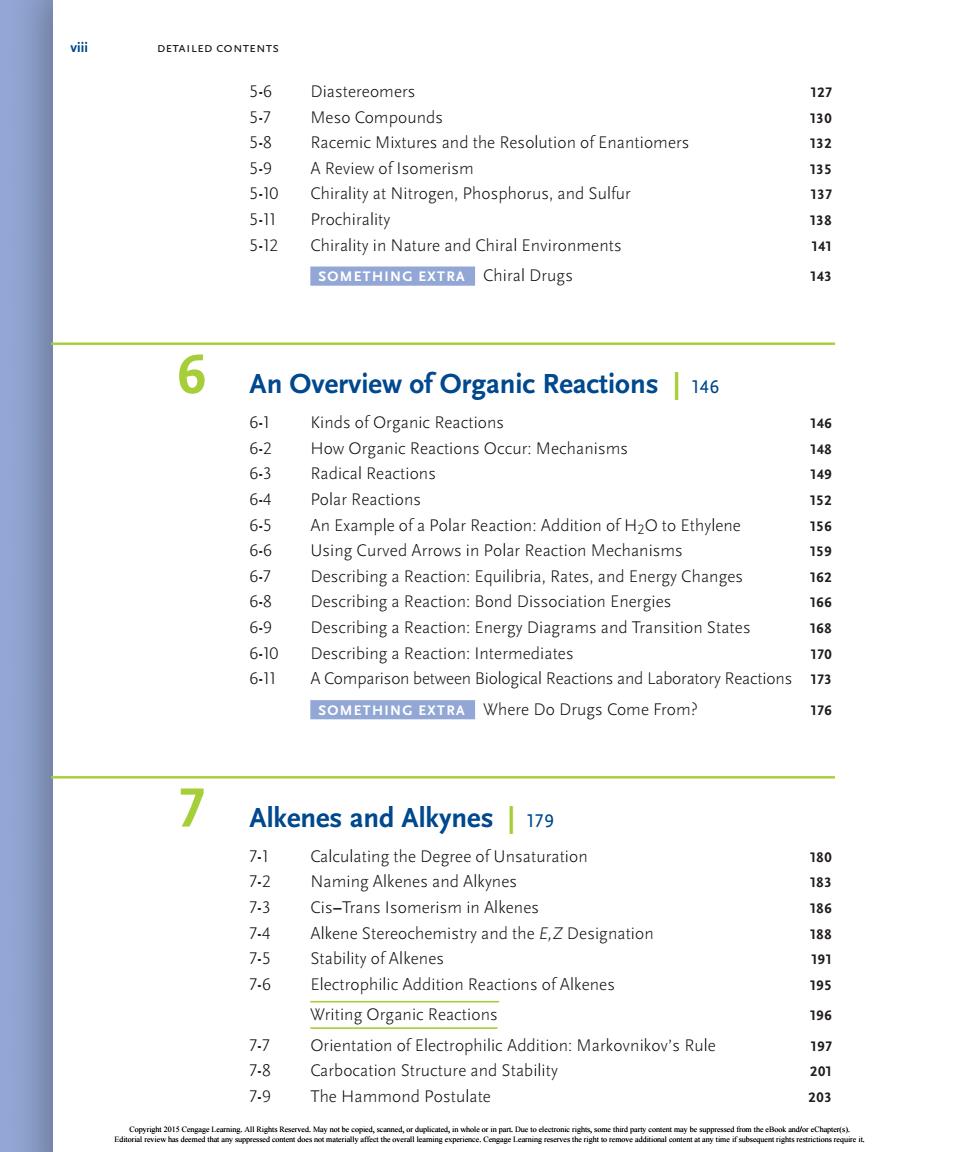
DETAILED CONTENTS 5.6 Diastereomers 5.) Meso Compounds 1 5-8 Racemic Mixtures and the Resolution of Enantiomers 132 5-9 A Review of Isomerism 5-10 Chirality at Nitrogen,Phosphorus,and Sulfur 13 5-11 Prochirality 38 5-12 Chirality in Nature and Chiral Environments 14 SOMETHING EXTRA Chiral Drugs An Overview of Organic Reactions 146 6-1 Kinds of Organic Reactions 146 6-2 How Organic Reactions Occur:Mechanisms 148 63 Radical reactions 6 Polar Reactions 2 65 An Example of a Polar Reaction:Addition of H2O to Ethylene 6-6 Using Curved Arrows in Polar Reaction Mechanisms 159 6-7 Describing a Reaction:Equilibria,Rates,and Energy Changes 162 6-8 Describing a Reaction:Bond Dissociation Energies 6-9 Describing a Reaction:Energy Diagrams and Transition States 68 6-10 Describing a Reaction:Intermediates 170 6-11 A Comparison between Biological Reactions and Laboratory Reactions SOMETHING EXTRA Where Do Drugs Come From? 176 Alkenes and Alkynes 179 7-1 Calculating the Degree of Unsaturation 72 180 Naming Alkenes and Alkynes 1 7-3 Cis-Trans Isomerism in Alkenes 186 Alkene Stereochemistry and the E.Z Designation 7-5 Stability of Alkenes 189 7-6 Electrophilic Addition Reactions of Alkene 195 Writing Organic Reactions 196 77 Orientation of Electrophilic Addition:Markovnikov's Rule 91 7-8 Carbocation Structure and Stability 7-9 The Hammond Postulate 203
viii DetaileD Contents 5-6 Diastereomers 127 5-7 Meso compounds 130 5-8 Racemic Mixtures and the Resolution of Enantiomers 132 5-9 a Review of isomerism 135 5-10 chirality at nitrogen, phosphorus, and sulfur 137 5-11 prochirality 138 5-12 chirality in nature and chiral Environments 141 soMetHinG eXtra chiral Drugs 143 6 an overview of organic reactions | 146 6-1 Kinds of organic Reactions 146 6-2 how organic Reactions occur: Mechanisms 148 6-3 Radical Reactions 149 6-4 polar Reactions 152 6-5 an Example of a polar Reaction: addition of h2o to Ethylene 156 6-6 Using curved arrows in polar Reaction Mechanisms 159 6-7 Describing a Reaction: Equilibria, Rates, and Energy changes 162 6-8 Describing a Reaction: Bond Dissociation Energies 166 6-9 Describing a Reaction: Energy Diagrams and transition states 168 6-10 Describing a Reaction: intermediates 170 6-11 a comparison between Biological Reactions and laboratory Reactions 173 soMetHinG eXtra where Do Drugs come From? 176 7 alkenes and alkynes | 179 7-1 calculating the Degree of Unsaturation 180 7-2 naming alkenes and alkynes 183 7-3 cis–trans isomerism in alkenes 186 7-4 alkene stereochemistry and the E,Z Designation 188 7-5 stability of alkenes 191 7-6 Electrophilic addition Reactions of alkenes 195 writing organic Reactions 196 7-7 orientation of Electrophilic addition: Markovnikov’s Rule 197 7-8 carbocation structure and stability 201 7-9 the hammond postulate 203 42912_00_FM_i-xxiv.indd 8 1/16/14 3:00 PM Copyright 2015 Cengage Learning. All Rights Reserved. May not be copied, scanned, or duplicated, in whole or in part. Due to electronic rights, some third party content may be suppressed from the eBook and/or eChapter(s). Editorial review has deemed that any suppressed content does not materially affect the overall learning experience. Cengage Learning reserves the right to remove additional content at any time if subsequent rights restrictions require it
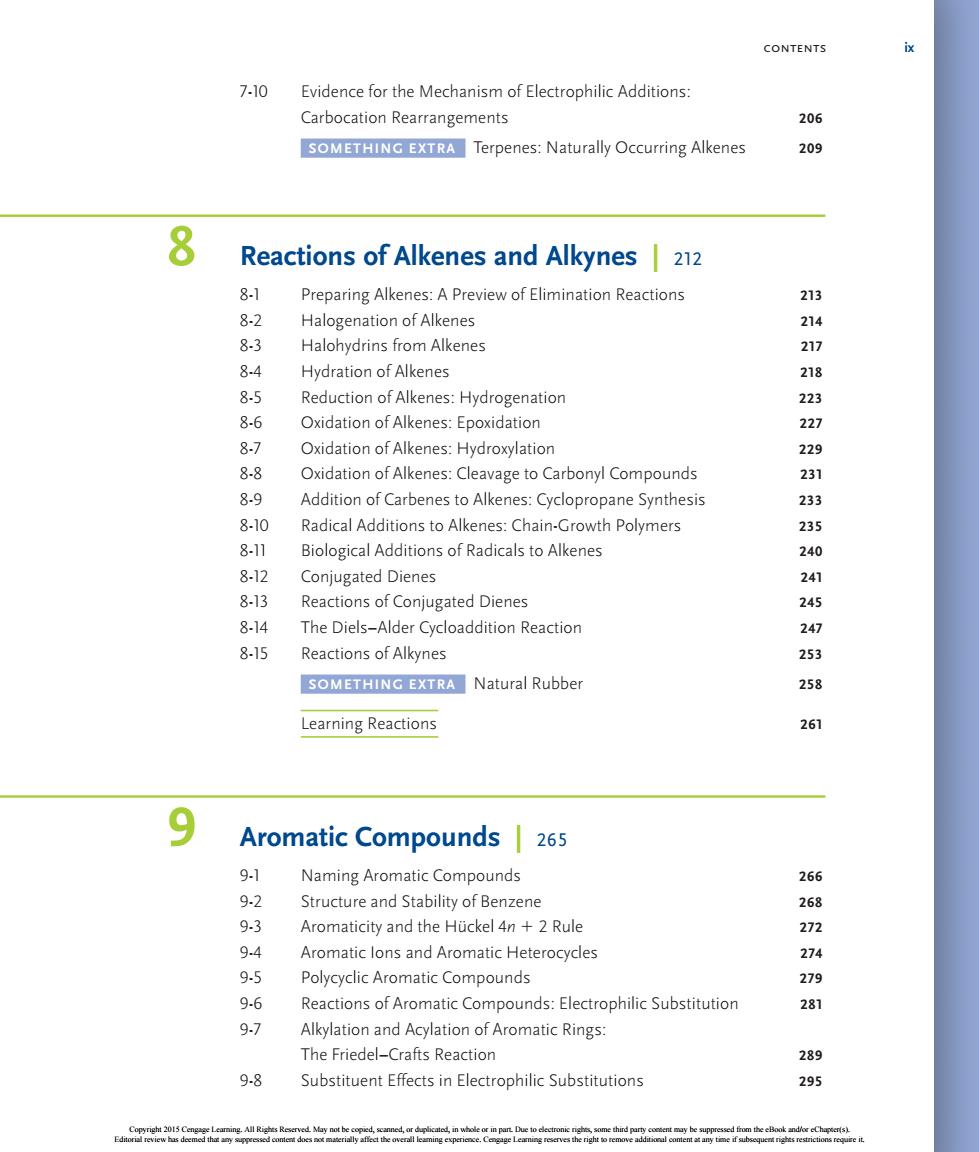
CONTENTS 7-10 Evidence for the Mechanism of Electrophilic Additions: Carbocation Rearrangements 206 SOMETHING EXTRA Terpenes:Naturally Occurring Alkenes 209 8 Reactions of Alkenes and Alkynes 212 8-1 Preparing Alkenes:A Preview of Elimination Reactions 213 8-2 Halogenation of Alkenes 214 8-3 Halohydrins from Alkenes 84 Hydration of Alkenes 218 8-5 Reduction of Alkenes:Hydrogenation 2 8-6 Oxidation of Alkenes:Epoxidation 27 Oxidation of Alkenes:Hydroxylation 2 8-8 Oxidation of Alkenes:Cleavage to Carbonyl Compounds 231 8.9 Addition of Carbenes to Alkenes:Cyclopropane Synthesis 233 8.10 Radical Additions to Alkenes:Chain-Growth Polymers 235 811 Biological Additions of Radicals to Alkenes 240 8.12 Conjugated Dienes 241 8-13 Reactions of Conjugated Dienes 245 8-14 The Diels-Alder Cycloaddition Reactior 8-15 Reactions of Alkynes 253 SOMETHING EXTRA Natural Rubber 258 Learning Reactions 261 9 Aromatic Compounds 265 91 Naming Aromatic Compounds 266 9 Structure and Stability of Benzene 268 Aromaticity and the Huckel 4n +2 Rule 272 94 Aromatic lons and Aromatic Heterocycles 274 95 Polycyclic Aromatic Compounds 279 9-6 Reactions of Aromatic Compounds:Electrophilic Substitution 97 Alkylation and Acylation of Aromatic Rings The Friedel-Crafts Reaction 289 9-8 Substituent Effects in Electrophilic Substitutions 295
Contents ix 7-10 Evidence for the Mechanism of Electrophilic additions: carbocation Rearrangements 206 soMetHinG eXtra terpenes: naturally occurring alkenes 209 8 reactions of alkenes and alkynes | 212 8-1 preparing alkenes: a preview of Elimination Reactions 213 8-2 halogenation of alkenes 214 8-3 halohydrins from alkenes 217 8-4 hydration of alkenes 218 8-5 Reduction of alkenes: hydrogenation 223 8-6 oxidation of alkenes: Epoxidation 227 8-7 oxidation of alkenes: hydroxylation 229 8-8 oxidation of alkenes: cleavage to carbonyl compounds 231 8-9 addition of carbenes to alkenes: cyclopropane synthesis 233 8-10 Radical additions to alkenes: chain-growth polymers 235 8-11 Biological additions of Radicals to alkenes 240 8-12 conjugated Dienes 241 8-13 Reactions of conjugated Dienes 245 8-14 the Diels–alder cycloaddition Reaction 247 8-15 Reactions of alkynes 253 soMetHinG eXtra natural Rubber 258 learning Reactions 261 9 aromatic Compounds | 265 9-1 naming aromatic compounds 266 9-2 structure and stability of Benzene 268 9-3 aromaticity and the hückel 4n 1 2 Rule 272 9-4 aromatic ions and aromatic heterocycles 274 9-5 polycyclic aromatic compounds 279 9-6 Reactions of aromatic compounds: Electrophilic substitution 281 9-7 alkylation and acylation of aromatic Rings: the Friedel–crafts Reaction 289 9-8 substituent Effects in Electrophilic substitutions 295 42912_00_FM_i-xxiv.indd 9 1/16/14 3:00 PM Copyright 2015 Cengage Learning. All Rights Reserved. May not be copied, scanned, or duplicated, in whole or in part. Due to electronic rights, some third party content may be suppressed from the eBook and/or eChapter(s). Editorial review has deemed that any suppressed content does not materially affect the overall learning experience. Cengage Learning reserves the right to remove additional content at any time if subsequent rights restrictions require it
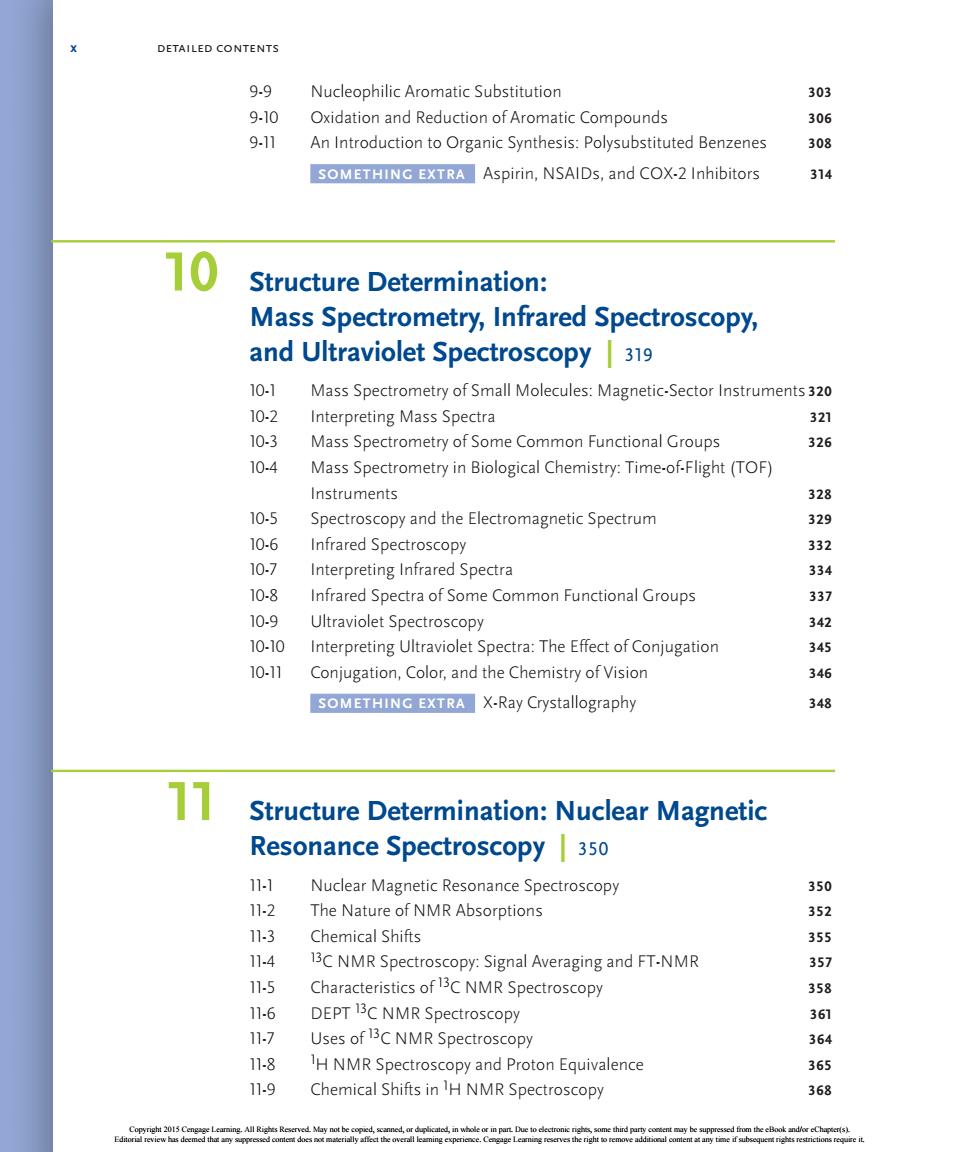
DETAILED CONTENTS 99 Nucleophilic Aromatic Substitution 303 9-10 Oxidation and Reduction of Aromatic Compounds 306 911 An Introduction to Organic Synthesis:Polysubstituted Benzenes 308 SOMETHING EXTRA Aspirin,NSAIDs,and COX-2 Inhibitors 314 Structure Determination: Mass Spectrometry,Infrared Spectroscopy, and Ultraviolet Spectroscopy 319 10-1 Mass Spectrometry of Small Molecules:Magnetic-Sector Instruments 320 10-2 Interpreting Mass Spectra 10-3 Mass Spectrometry of Some Common Functional Groups 10-4 Mass Spectrometry in Biological Chemistry:Time-of-Flight(TOF) Instruments 328 10-5 Spectroscopy and the Electromagnetic Spectrum 329 10-6 Infrared Spectroscopy 332 10-7 Interpreting Infrared Spectra 3 10-8 Infrared Spectra of Some Common Functional Groups 37 10-9 Ultraviolet Spectroscopy 34 10-10 Interpreting Ultraviolet Spectra:The Effect of Conjugation 10-11 Conjugation,Color,and the Chemistry ofVision 346 SOMETHING EXTRA X-Ray Crystallography Structure Determination:Nuclear Magnetic Resonance Spectroscopy 350 1l-1 Nuclear Magnetic Resonance Spectroscopy 350 11-2 The Nature of NMR Absorptions 11-3 Chemical Shifts 55 11-4 13C NMR Spectroscopy:Signal Averaging and FT-NMR 3 1-5 Characteristics of13C NMR Spectroscopy 358 11-6 DEPT 13C NMR Spectroscopy 11-7 Uses of 13C NMR Spectroscopy 364 1-8 H NMR Spectroscopy and Proton Equivalence 365 119 Chemical Shifts in IH NMR Spectroscopy 368
x DetaileD Contents 9-9 nucleophilic aromatic substitution 303 9-10 oxidation and Reduction of aromatic compounds 306 9-11 an introduction to organic synthesis: polysubstituted Benzenes 308 soMetHinG eXtra aspirin, nsaiDs, and coX-2 inhibitors 314 10 structure Determination: Mass spectrometry, infrared spectroscopy, and Ultraviolet spectroscopy | 319 10-1 Mass spectrometry of small Molecules: Magnetic-sector instruments 320 10-2 interpreting Mass spectra 321 10-3 Mass spectrometry of some common Functional groups 326 10-4 Mass spectrometry in Biological chemistry: time-of-Flight (toF) instruments 328 10-5 spectroscopy and the Electromagnetic spectrum 329 10-6 infrared spectroscopy 332 10-7 interpreting infrared spectra 334 10-8 infrared spectra of some common Functional groups 337 10-9 Ultraviolet spectroscopy 342 10-10 interpreting Ultraviolet spectra: the Effect of conjugation 345 10-11 conjugation, color, and the chemistry of Vision 346 soMetHinG eXtra X-Ray crystallography 348 11 structure Determination: nuclear Magnetic resonance spectroscopy | 350 11-1 nuclear Magnetic Resonance spectroscopy 350 11-2 the nature of nMR absorptions 352 11-3 chemical shifts 355 11-4 13c nMR spectroscopy: signal averaging and Ft-nMR 357 11-5 characteristics of 13c nMR spectroscopy 358 11-6 DEpt 13c nMR spectroscopy 361 11-7 Uses of 13c nMR spectroscopy 364 11-8 1 h nMR spectroscopy and proton Equivalence 365 11-9 chemical shifts in 1 h nMR spectroscopy 368 42912_00_FM_i-xxiv.indd 10 1/16/14 3:00 PM Copyright 2015 Cengage Learning. All Rights Reserved. May not be copied, scanned, or duplicated, in whole or in part. Due to electronic rights, some third party content may be suppressed from the eBook and/or eChapter(s). Editorial review has deemed that any suppressed content does not materially affect the overall learning experience. Cengage Learning reserves the right to remove additional content at any time if subsequent rights restrictions require it